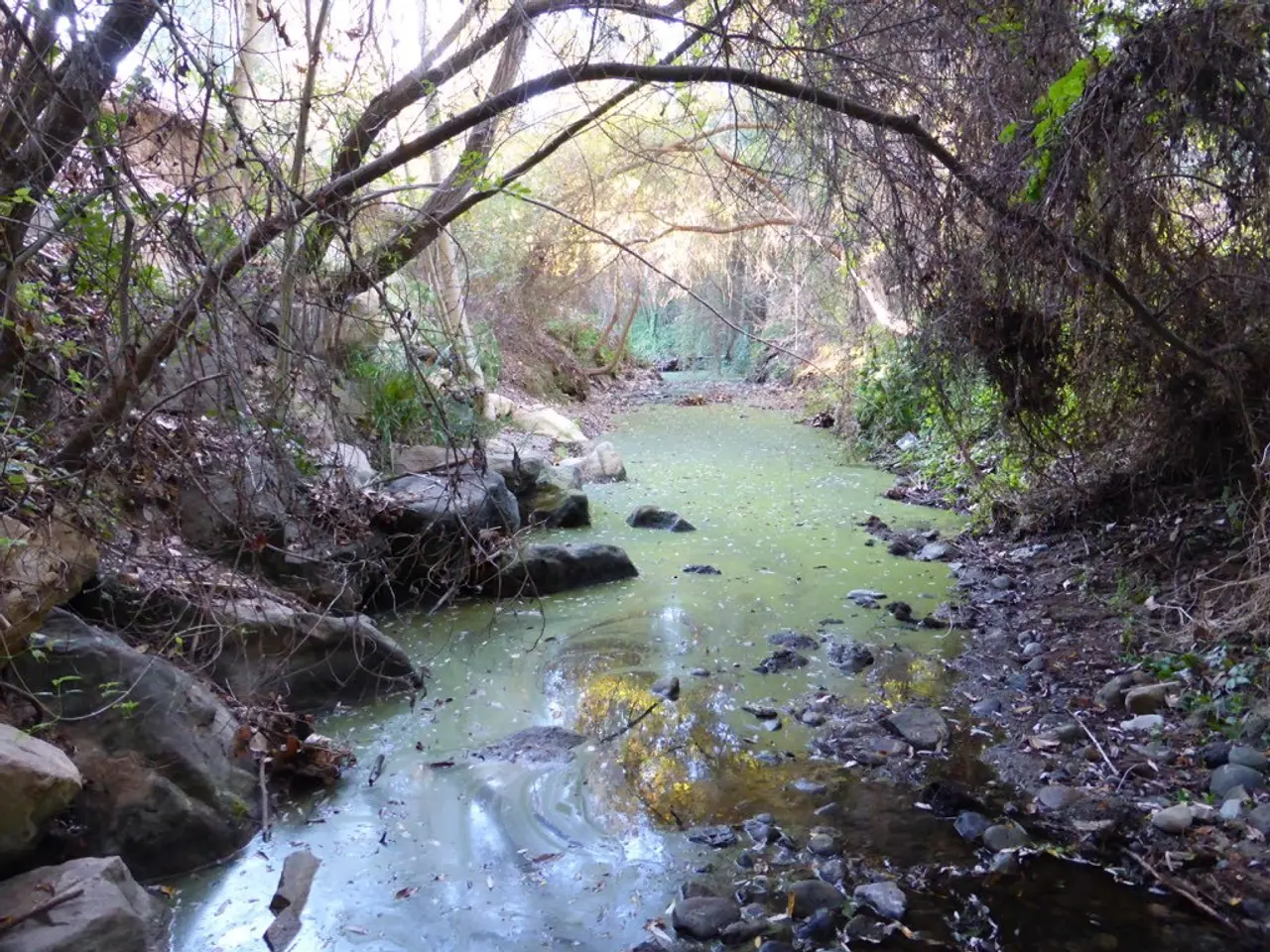Beach water safety: essential checks before taking a dip in the ocean
### Common Signs of Harmful Organisms in Water Bodies: Blue-Green Algae, Vibrios, and Cercariae
In recent years, the importance of understanding the potential health hazards present in water bodies has become increasingly significant. Three common organisms that may pose a risk to swimmers and aquatic life are blue-green algae, vibrios, and cercariae.
#### Blue-Green Algae
Blue-green algae, also known as cyanobacteria, can often be identified by their formation of thick mats or scums on the water surface[1][3]. These organisms are known to appear in various colours, including bright green, blue, brown, white, red, or purple[1][3]. It is essential to be aware that blue-green algae can produce cyanotoxins, which can cause skin irritation, headaches, gastrointestinal upset, and severe symptoms such as liver damage or respiratory distress in humans and animals[1][3]. These toxins are typically found in warm, slow-moving or still waters with excess nutrients[1][3].
#### Vibrios
Vibrios are bacteria that are commonly associated with marine environments, and they are not visually distinct like algae. They are typically found in coastal waters, particularly in areas where their hosts, such as oysters, are present[2]. Vibrios can cause gastrointestinal illness (e.g., cholera, vibriosis) in humans who consume contaminated seafood or come into contact with infected water[2]. Specific literature on recognizing vibrios in water bodies visually is limited, as they are not typically identified by appearance but through microbiological testing.
#### Cercariae
Cercariae are the larval stage of certain parasites (e.g., schistosomes) and are microscopic, making them not typically visible to the naked eye. They are found in water where freshwater snails are present, as snails are their intermediate hosts[3]. Cercariae can infect humans through contact with contaminated water, typically causing swimmer's itch or more severe conditions like schistosomiasis.
## Precautions When Encountering These Organisms
### General Precautions
1. **Avoid Suspicious Water**: Steer clear of water with visible signs of algae blooms or other unusual discoloration. 2. **Use Protective Gear**: Wear protective clothing when handling water or aquatic organisms. 3. **Check Local Advisories**: Look for advisory signs or warnings posted near water bodies regarding harmful algal blooms or other health risks.
### Specific to Blue-Green Algae
1. **Monitor Pets**: Keep pets away from water with algae blooms, as they can ingest toxins while swimming or licking their fur[3]. 2. **Do Not Drink Contaminated Water**: Avoid drinking untreated water from areas with algae blooms, as cyanotoxins can be harmful[1][3].
### Specific to Vibrios
1. **Avoid Consuming Raw or Undercooked Seafood**: Ensure seafood is cooked thoroughly before consumption to reduce the risk of vibriosis. 2. **Practice Good Hygiene**: Wash hands thoroughly after handling seafood or water potentially contaminated with vibrios.
### Specific to Cercariae
1. **Avoid Contact with Infested Snails**: When interacting with freshwater environments, avoid touching snails or areas where they are known to exist. 2. **Dry Off Thoroughly**: After swimming, dry off thoroughly to prevent cercariae from penetrating the skin.
For more information about the water quality of a particular body of water, it is advised to consult the websites of the German Federal Environmental Agency, the Federal Institute of Hydrology, and the European Environment Agency. Additionally, it's essential to read local press for updates on water quality in the Baltic Sea, as swimming in lakes not designated as bathing waters may not be mentioned in such reports.
In the event of heavy rain, it's important to be aware that dirt can pollute a lake, making the water murky and potentially unsafe for swimming. Lower water levels in summer can mean that a higher proportion of water in bodies of water has passed through wastewater treatment plants, which may contribute to pollution. Wastewater treatment plants nearby can also cause pollutants in lakes.
If the water is too murky to see one's feet while standing knee-deep, it might be unsafe to swim. Dead fish are a sign of potential health hazards in lakes. In addition, blue-green algae are more likely to appear after prolonged high temperatures, a lot of sunshine, and if fertilizers have been used nearby.
Severe cases of wound infection from vibrios are more common in people with weakened immune systems. Cercariae need water temperatures around 20 degrees Celsius. Local authorities will warn if a body of water is affected by cercariae. It's advised to avoid the shore plants area and shallow water, and to rub vigorously with a towel and put on fresh clothes after swimming.
It's crucial to remember that vibrios and cercariae are tiny organisms that cannot be seen with the naked eye. Existing wounds can worsen due to vibrios, and cercariae can cause swimmer's itch or more severe conditions like schistosomiasis.
By being aware of the potential health hazards in water bodies and taking necessary precautions, swimmers can help protect themselves and the environment.
- In the realm of health-and-wellness, it is essential to be informed about environmental-science phenomena such as blue-green algae, a harmful organism that can produce cyanotoxins in water bodies, potentially causing skin irritation, gastrointestinal upset, and even severe symptoms like liver damage or respiratory distress in humans and animals.
- Fitness-and-exercise enthusiasts should be aware that Vibrios, another common organism, are bacteria often associated with marine environments, which can cause gastrointestinal illness in humans who consume contaminated seafood or come into contact with infected water.
- Nutritionally conscious individuals should be aware that improper handling of seafood, like consistency to consume raw or undercooked seafood, can increase the risk of vibriosis, a health hazard associated with Vibrios.




